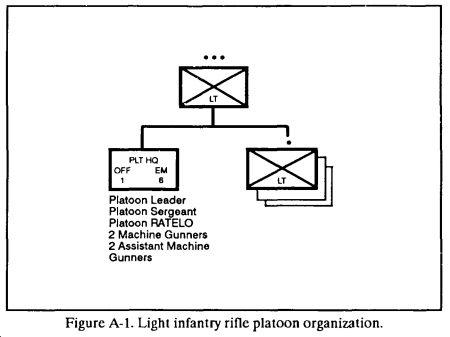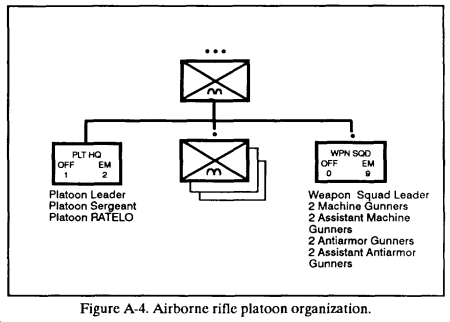APPENDIX A - ORGANIZATION
All dismounted infantry units use the same basic doctrinal principles in combat, but some differences exist between organizations. Leaders must know these differences.
A-1. RIFLE PLATOON
Most units operate from a modified table of organization and equipment (MTOE) based on their organization, mission, and location. There are five different types of rifle platoon organizations. These rifle platoons are discussed below.
a. The light infantry rifle platoon consists of three rifle squads and a platoon headquarters with two machine gun teams (Figure A-1). Each machine gun team consists of two men–a machine gunner and an assistant machine gunner.

b. The infantry, air assault, and airborne rifle platoons consist of a platoon headquarters, three rifle squads, and a weapons squad ( Figures A-2 through A-4 ). There are two machine gun teams and two antiarmor teams in the weapons squad. Each machine gun team and antiarmor team consists of two men–a gunner and an assistant gunner.



c. The ranger rifle platoon consists of a platoon headquarters, three rifle squads, and a machine gun squad (Figure A-5). There are three machine gun crews in the machine gun squad. Each machine gun crew consists of three men–a machine gunner, an assistant machine gunner, and an ammunition bearer.

A-2. RIFLE SQUAD
The most common rifle squad has nine soldiers (Figure A-6). It fights as two fire teams. The squad has one squad leader, two fire team leaders, two automatic riflemen, two riflemen, and two grenadiers.

A-3. DUTIES AND RESPONSIBILITIES
To complete all assigned tasks, every soldier in the platoon must do his job. Each soldier must accomplish his specific duties and responsibilities and be a part of the team.
a. Rifle Platoon Leader. He is responsible for all that the platoon does or fails to do. This includes the tactical employment, training, administration, personnel management, and logistics of his platoon. He must know his men and how to employ the platoon’s weapons. He is responsible for positioning and employing all assigned or attached crew-served weapons. He must also know how to employ supporting weapons. The rifle platoon leader–
(1) Sets the example and the standards.
(2) Leads the platoon in support of company and or battalion missions.
(3) Informs his commander of his actions when operating without orders.
(4) Plans with the help of the platoon sergeant, squad leaders, and other key personnel (FO, leaders of attachments, and so on).
(5) Stays abreast of the situation and goes where he is needed to supervise, issue FRAGOs, and accomplish the mission.
(6) Requests more support for his platoon from the company commander to perform its mission, if needed.
(7) Assists the platoon sergeant in planning and coordinating the platoon’s CSS effort.
(8) During planning, receives on-hand status reports from the platoon sergeant, squad leaders, or both.
(9) Reviews platoon requirements based on the tactical plan.
(10) Develops a casualty evacuation plan.
(11) During execution, checks the work of the platoon sergeant and squad leaders.
(12) Ensures the soldier’s load is reasonable.
b. Rifle Platoon Sergeant. This soldier is the senior NCO in the platoon and second in succession of command. He helps and advises the platoon leader, and leads the platoon in the platoon leader’s absence. He supervises the platoon’s administration, logistics, and maintenance. He may prepare and issue paragraph 4 of the platoon OPORD. The rifle platoon sergeant is responsible for individual training. He must ensure that soldiers can perform their individual MOS tasks. He advises the platoon leader on appointments, promotions and reductions, assignments, and discipline of NCOs and enlisted soldiers in the platoon. The rifle platoon sergeant–
(1) Organizes and controls the platoon CP IAW the unit SOP, platoon leader guidance, and METT-T factors.
(2) Trains the crews and employs the platoon’s machine guns IAW the platoon leader’s orders, appropriate field manuals, unit SOP, and METT-T factors.
(3) Receives squad leaders’ requests for rations, water, and ammunition. Works with the company’s first sergeant or XO to request resupply. He also directs the routing of supplies and mail.
(4) Directs the platoon aidman and platoon aid and litter teams in moving casualties to the rear.
(5) Maintains platoon strength information, consolidates and forwards the platoon’s casualty reports ( DA Forms 1155 and 1156 ), and receives and orients replacements.
(6) Monitors the morale, discipline, and health of platoon members.
(7) Takes charge of task-organized elements in the platoon during tactical operations. This can include, but is not limited to, the following:
-
Quartering parties.
-
Security forces in withdrawals.
-
Support elements in raids or attacks.
-
Security patrols in night attacks.
(8) Coordinates and supervises company-directed platoon resupply operations.
(9) Ensures that supplies are distributed IAW the platoon leader’s guidance and direction.
(10) Ensures that ammunition, supplies, and loads are properly and evenly distributed (a critical task during consolidation and reorganization).
(11) Ensures the casualty evacuation plan is complete and executed properly.
c. Rifle Squad Leader. This soldier is responsible for all that the rifle squad does or fails to do. He is a tactical leader and, as such, leads by example. The rifle squad leader–
(1) Controls the maneuver of his squad and its rate and distribution of fire.
(2) Trains his squad on the individual and collective tasks required to sustain combat effectiveness.
(3) Manages the logistical and administrative needs of his squad. He requests and issues ammunition, water, rations, and special equipment.
(4) Maintains accountability of his soldiers and equipment.
(5) Completes casualty feeder reports and reviews the casualty reports completed by squad members.
(6) Submits requests for awards and decorations.
(7) Directs the maintenance of the squad’s weapons and equipment.
(8) Inspects the condition of soldiers’ weapons, clothing, and equipment.
(9) Ensures that material and supplies are distributed to the soldiers in the squad.
(10) Keeps the platoon sergeant/leader informed on squad supply status and squad requirements.
(11) Ensures supplies and equipment are internally cross-leveled within the squad.
d. Weapons Squad Leader (Infantry, Airborne, and Air Assault Divisions Only). This soldier is responsible for all that the weapons squad does or fails to do. His duties are the same as the rifle squad leader. He also controls the machine guns and MAWs in support of the platoon’s mission. He advises the platoon leader on employing his squad.
e. Machine Gun Squad Leader (Ranger Rifle Company Only). This soldier is responsible for all that the machine gun squad does or fails to do. His duties are the same as the rifle squad leader, and he also controls the machine guns in support of the platoon’s mission. He advises the platoon leader on employing the squad.
f. Team Leader. This soldier is a fighting leader who leads by personal example and helps the squad leader as required. He controls the movement of his fire team and the rate and placement of fire by leading from the front and using the proper commands and signals. He maintains accountability of his soldiers and equipment. He ensures his soldiers maintain the unit standards in all areas.
g. Platoon Aidman. This soldier helps the platoon sergeant direct aid and litter teams; he monitors the health and hygiene of the platoon. The platoon aidman–
(1) Treats casualties and assists in their evacuation under the control of the platoon sergeant.
(2) Aids the platoon leader/sergeant in field hygiene matters, personally checks the health and physical condition of platoon members.
(3) Requests Class VIII (medical) supplies through the platoon sergeant.
(4) Provides technical expertise and supervision of the combat lifesavers.
(5) Carries out other tasks assigned by the platoon leader and platoon sergeant.
h. Platoon Radiotelephone Operator. The platoon RATELO must know the use and care of the radio to include waterproofing and presetting frequencies, the use of the SOI, and how to construct and erect field-expedient antennas.
i. Fire Support Team. The company has a fire support team attached from the DS FA battalion. This team provides each platoon with a two-soldier FO party–an FO and his RATELO.
NOTE: FO party for a ranger rifle company is assigned not attached.
(1) Forward observer. The FO acts as the eyes of the FA and mortars. He works for the platoon leader. The FO’s main responsibilities are to locate targets and to call for and adjust indirect fire support. The FO must be familiar with the terrain that the platoon is operating in and the tactical situation. He must know the mission, the concept, and the platoon’s scheme of maneuver and priority of fires. The FO must–
-
Inform the FIST headquarters of platoon activities and the fire support situation.
-
Prepare and use situation maps, overlays, and terrain sketches.
-
Call for and adjust fire support.
-
Operate as a team with the RATELO.
-
Select targets to support the platoon’s mission based on the company OPORD, platoon leader’s guidance and an analysis of METT-T factors.
-
Select OPs and movement routes to and from them.
-
Maintain communications as prescribed by the FSO.
-
Operate the digital message device.
-
Maintain the six-digit grid coordinates of his location.
(2) Radiotelephone operator. The RATELO’s main duties are to set up, operate, and maintain the FO party’s communications equipment. At times, he must also perform the duties of the FO for the platoon.